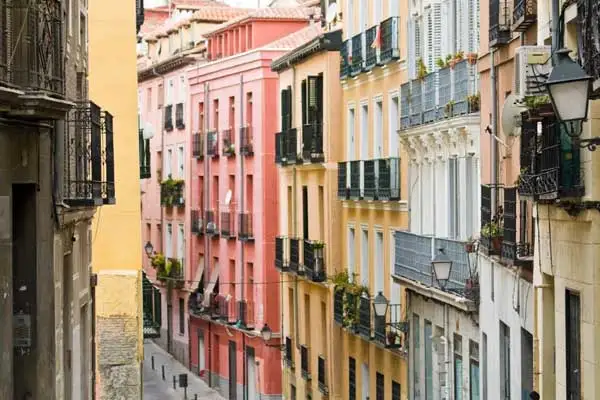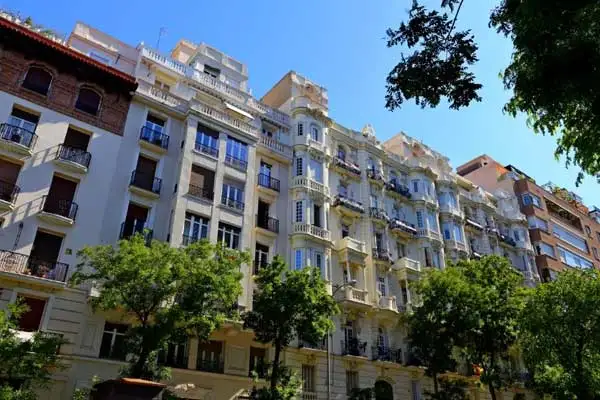If you’re planning a move to Madrid, the first thing you’ll need to do is find a place to call home. Start by choosing the neighborhood that is best for you.
Madrid has many different areas with distinct lifestyles in various price ranges. Here’s a brief, but by no means exhaustive, overview:
Sol: Madrid’s center and beating heart is full of tourists, action, and excitement. It’s also expensive.
Palacio/Opera: Elegant and convenient, this area is quieter than Sol with fewer tourists but still pricey.
Lavapies: Madrid’s multi-cultural bohemian neighborhood is filled with ethnic markets and restaurants as well as tourists. It’s a 24-hour party. Would suit those on a moderate budget.

Las Letras: Also known as Huertas, the literary district near the Prado is exclusive, touristy, and very expensive.
Malasaña: Hip and fun with plenty of nightlife, this district is a favorite of expats, students, and tourists. In terms of prices, it’s moderate to expensive.
Chueca: Ultimate LGBTQ+-friendly neighborhood offering a trendy shopping and non-stop party atmosphere at a high price-point.
La Latina: One of the oldest and most charming areas, La Latina is a center for vibrant nightlife with lots of tourists. Moderate to expensive.

Chamberi: This upper-middle-class residential area has convenient access to public transportation and no tourists. You’ll find families, young professionals, and university students. It’s expensive but worth it. This is where I live and I pay €850 ($1,033) a month for my studio apartment.
Salamanca: This conservative, old-money neighborhood borders leafy Retiro Park. Expensive.
Recoletos: Uber-elegant and very expensive neighborhood.
Puerta de Angel: Just outside of the center, across the Segovia bridge, this residential neighborhood boasts easy access to the Madrid Rio recreational area. Price-wise, it’s moderate.
Usera: Madrid’s Chinatown is popular with immigrants and young people and is an inexpensive place to call home.
Vallecas: This working-class neighborhood on the outskirts of the city promises life without tourists. Inexpensive.
Legazpi: This formerly inexpensive, now moderately priced area has become hip by proximity to the Matadero arts complex and Madrid Rio recreational area.
Once you’ve identified the neighborhoods that interest you, search online for available properties. Idealista.com is a popular website because it allows you to draw an area on the map to search. It also offers many filters. Use them. Unless you are young and strong enough to carry groceries and luggage upstairs, you’ll want an elevator. You will definitely need air-conditioning in July and August. Look on the map of each listing to see if there is a metro stop nearby. You can also check listings on Fotocasa.com and Spotahome.com.

Look to see if a property is represented by a real estate firm or the owner. Real estate companies are going to charge you a one-month, non-refundable commission. Properties by owner are hard to find but can save you a big chunk of money. Also make a note of how many months deposit the landlord is asking. One month is the minimum. Properties with several months deposit could be a scam. Even if they are legitimate, it could be hard to get it all returned when you move out.
Here’s some examples of properties currently on offer:
In Chamberi, a recently-renovated, furnished, two-bedroom, two-bathroom, 915-square-foot apartment with three balconies, hardwood floors, and air-conditioning, on the third floor of a building with an elevator, rents for €1,250 ($1,518) per month.
In Chueca, a furnished, one-bedroom, one-bathroom apartment with a spacious patio for entertaining, rents for €920 ($1,117) per month. It’s 657 square feet, and has air-conditioning.
In Usera, gardens surround a petite, furnished, renovated, one-bedroom apartment with air-conditioning. On the mezzanine level of a building with an elevator, this 484-square-foot pied-à-terre rents for €595 ($722) a month by owner.
When you’ve found some rentals to suit your tastes, make appointments to see your favorites. If possible, take a bilingual Spanish friend with you so that you understand exactly what the real estate agent or owner is requiring.
When you find your new home, you will sign a contract, probably in a real estate office. Ask for a version of the contract in English as well as in Spanish. Most contracts are a one-year lease that automatically renews for five years. Landlords can only raise the rent by the same percentage as the cost-of-living index. Usually, after one year, tenants can terminate the lease with 30-days’ notice. Negotiate down any exorbitant cleaning fees. Again, take a bilingual Spanish friend with you to watch out for your interests.
Then… Move in!
Related Articles
There Are Many Reasons for Moving to Spain
